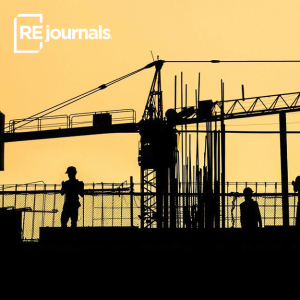Delays, Labor Shortages and COVID Stress: Construction Firms Working Through Challenging Times
 September 27, 2021 | Construction firms are busy again as developers react to increasing demand for new commercial properties, especially in the industrial and multifamily sectors. But being busy doesn’t mean being stress-free.
September 27, 2021 | Construction firms are busy again as developers react to increasing demand for new commercial properties, especially in the industrial and multifamily sectors. But being busy doesn’t mean being stress-free.
Commercial construction firms are facing a severe shortage in key materials. They’re also dealing with a lack of labor and rising prices.
How are they tackling these challenges? We spoke with Eric Gowin, founder and managing member of Contegra Construction Company, to find out. Contegra has offices in St. Charles, Missouri, and Edwardsville, Illinois, both in the St. Louis market, and works in markets across the Midwest and the country. Gowin, then, is familiar with the difficulties construction firms face today.
How busy is Contegra today? Is construction activity on the rise?
Eric Gowin: We have been pretty steady. When the pandemic hit, we had a couple of jobs hit the pause button. Within 30 days, we started seeing a lot of new opportunities, mostly in the warehouse and distribution and ecommerce space.
Warehouse/distribution is a big part of our business now. It probably accounts for 70 percent of our business. We’ve started seeing an uptick in new spec buildings and build-to-suits, too, with the warehouse work. Some even have some manufacturing component.
How about other commercial sectors? Are you seeing any demand for new construction there?
Gowin: Office and retail requests went way down. Office, for us, we haven’t seen much movement at all. With retail we are starting to see some activity again. Some retailers have poked their heads out again and are starting look for new space.
What are some of the reasons for the big upswing in warehouse construction?
Gowin: The pandemic probably highlighted some of our constraints in logistics and delivery throughout the country. It made companies think about the amount of warehouse stock they could sit on and how quickly it turned over. During the pandemic, demand for product sped up so fast. It depleted a lot of warehouse logistics capacity. Out of that, grew a need for more space. Companies are still reacting to that and building new warehouses across the country.
You are seeing that now with the chips that automotive makers need. There are huge delays with that. There was the freeze in Texas that caused a plastics shortage. It seems like there is something new every day that causes shortages.
Does St. Louis’ central location help make it an attractive location for companies opening new warehouses?
Gowin: We have a great highway system here. We have a good river system. We have all the Class-5 railroads, too. St. Louis is a good logistics hub. I’d say our main competitors are Kansas City, Indianapolis and Memphis. From what I hear, I do know that Kansas City is really busy, too. Indianapolis has been extremely busy. We have a lot of work in the Kansas City market, too. Columbus, Ohio, is good, too.
How busy do you think the commercial construction industry will be the rest of this year and heading into 2022?
Gowin: There is still plenty of demand. And it’s not just this year and next year that should be busy. From what we are seeing, it seems like the next three to five years are going to be brisk.
There is still plenty of demand. And it’s not just this year and next year that should be busy. From what we are seeing, it seems like the next three to five years are going to be brisk.
Can you talk about the materials shortages that are hitting construction projects across the country? How big of a challenge is that?
Gowin: It is a major challenge. Two major components that are in short supply are structural steel and roof insulation. For structural steel, the lead times used to be 12 to 16 weeks. Now it is taking 30 weeks or more to get it. That has really been a challenge. Some developers are choosing to pre-purchase steel and then assign it to general contractors to make sure they can meet their development schedules. That has helped somewhat.
We are also seeing big delays with polyiso roof insulation. That has been in incredibly short supply. Those lead times are getting way out there, too.
How are you dealing with these delays?
Gowin: For the steel, we have been working backwards from the delivery date to make sure we can stick to our schedule. On the roof insulation, we have been putting temporary membranes down to keep construction on pace. If we are working on a large office development, say, we’ll put a membrane down on one corner of the building. It’s not practical to put it on all over the building, especially if you’re building on spec. But in a build-to-suit, temporary membranes in some locations have worked well for us.
Have you ever seen material delays of this length before?
Gowin: Not in my lifetime. Another one we’ve run into is getting dock doors. Those delivery dates are getting way out there, too. The delays are really hitting all facets of construction.
Do clients understand this?
Gowin: They do. They probably have it built into their core businesses, too, with their supply chains. It can still be difficult, though, when they have lease commitments and are moving out of a facility before moving into a new one. It can be tough for clients to juggle that.
Are you seeing any signs of relief from these delays?
Gowin: We had heard that this winter and in the first quarter of next year that some of the kinks will work themselves out. That is yet to be seen. So far, it doesn’t seem to be heading in that direction.
What about labor? Is it difficult to find labor on construction projects?
Gowin: That has been another challenge. Our biggest shortage of labor has been building superintendents who travel to projects in different towns. Even project management in-house has been tight. It seems like in every job description in construction there is a shortage. I don’t know why it is. I think, especially when it comes to the construction of new distribution centers, everyone in the country is busy. General contractors are all busy. Everyone is looking for the same type of labor. That makes it difficult to find enough people for all the projects.
On a more positive note, are you seeing any good trends in the construction industry?
Gowin: We are hearing people talk more about planning for new projects other than warehouse and distribution centers. A lot of people are waiting to see how the pandemic plays out. I still hear that the multifamily market is strong. The interest rates are still good. In multifamily and industrial, we continue to see projects roll in the door or enter the planning stages. For the rest of the sectors, it’s wait and see.
Article courtesy of RE Journals




